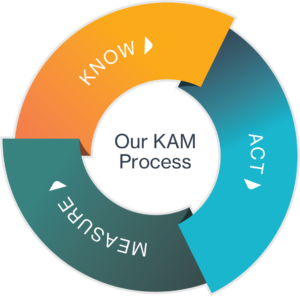Our KAM Process: Deep Dive into MEASURE
in Customer Engagement /Our KAM ProcessTM is a proven methodology for building customer engagement and transforming customer relationships. Here’s what it looks like:
- Know more, so you can plan better
- Act strategically and effectively to drive meaningful change
- Measure that change across multiple endpoints
We’ve already taken a closer look at the Know and the Act phase. In short, they’re about understanding your client’s goals and expectations so you can build an action plan that helps them achieve those goals and exceed those expectations. So how do you know if you were successful? This is where the Measure piece comes in.
It’s important to note that while Measure comes last in our Know, Act, Measure process, it’s actually embedded throughout. In order to measure the success of your action plan, you need to have established specific goals and success metrics up front. You can’t just look up 6 months into a project and say, “Wait! Shoot! We need to be tracking!” Measurement is most effective when you establish good baseline data in the “Know” phase and specific numerical goals in the “Act” phase. Then, 6 months in, you’ll know exactly what you’re tracking against and why.
It’s also important, as always, to emphasize the cyclical nature of Our KAM Process. Satisfied, engaged clients are going to want to start additional work right away. The results you’ve measured from your latest initiative become part of what you know heading into your next initiative.

There are 3 ways the Kapta platform helps you Measure:
- Tracking specific KPIs: Predetermined financial and operational goals set in collaboration with your customer. These are customer-focused metrics.
- Gauging overall account health: Customer engagement and client satisfaction as you work on their business. These are relationship-focused metrics.
- Quantifying internal success: Contract renewals, increased SOWs, and revenue generated as a result of your KAM efforts. These are internally-focused metrics.
We’ll look at specific examples of metrics below, but first we’ll review the importance of tracking data, and why many organizations still don’t do it.
Why We Don’t Always Keep Score
If you feel like your organization falls short of methodically and consistently tracking success metrics, don’t worry—you’re not alone. Quantifying results can be challenging for many reasons, including:
- It’s not a perfect process. Some things are easier to track than others. Revenue? Easy. Web traffic? Easy. Brand awareness? Doable, but more difficult. The more abstract or nuanced a metric, the more difficult it is to quantify.
- It takes effort. In order to measure what you’ve done for your customers, you have to take the time upfront to gather baseline data. This can be hard to do when things are moving quickly, especially if it’s not standard practice for you or your customers. Building a consistent analytics practice requires a concerted, tech-enabled process.
- It takes confidence. Numbers don’t lie. And sometimes, they tell you (and your client) that an initiative didn’t work. We’ll talk about why that’s okay in the next section.
Why Metrics Matter
Metrics are an invaluable resource to you and your customers. Because while numbers don’t always tell the whole story, they always tell an important story—and good or bad, they can help strengthen your relationship with a customer.
Let’s look at the good first. In a perfect world, your action plan is a smashing success, and you help your clients achieve increased product usage, sales growth, and revenue goals. The numbers will show that, and if you did a good job of highlighting metrics before and after your engagement with the client, you’ll be able to demonstrate the direct results of your efforts. Good metrics help you take reasonable credit for the work you’ve done. Whereas, if you didn’t pause to gather good data, you and your day-to-day contacts might think you did a good job, but you won’t have concrete evidence to support that claim. So how will you convince the CFO, who’s never worked with you and doesn’t know how awesome you are, that they should keep paying for your products or services? There’s nothing like a positive ROI to make your case.
Now, let’s look at the bad. (Which is really not so bad.) Say your efforts are not as fruitful as you’d like. You don’t get the sales or revenue your client hoped for. All is not lost! As long as you were aligned with your client going into the action plan, and both of you were making educated guesses about what might work, you’ve both learned something valuable in the process, namely: You need a new approach. As long as you internalize that knowledge and get to work brainstorming something new, a failed initiative can actually increase your value to a client in the context of a long-standing relationship. After all, a new vendor might come in and, without doing their research, suggest the exact thing you just tried—whereas you already know it won’t work, and you’re already working on a better idea.
Even in a worst-case scenario, where you track metrics, the initiative fails, and the client discontinues the relationship, you’ve still learned something from measuring results. When your next client wants to try something you already know won’t work, you’ll have real numbers to back up your point of view.
The point of all of this isn’t to scare you. It’s just to say, there’s never any reason not to try to quantify your impact. When the numbers are good, you’ll be able to show your customers exactly why it’s worth it for them to invest in your products or services. When the numbers aren’t good, you’re still learning. And if you’ve maintained strong client relationships throughout, you’ll be learning together, honing your approach for whatever comes next.
Examples of Metrics
Hopefully we’ve convinced you by now that you should be tracking metrics for every project.
(Sidenote: Here’s a perfect example of something that’s hard to track. How would we know if we’d convinced you? We can’t go into your brain and quantify conviction. We can’t count head nods. But we can use web traffic analytics to see how long the average reader stays on this page, which would give us a reasonable sense of how far down they read. And we can embed links below inviting you to get in touch—tracking those links can show us whether the post was generally compelling. And finally, we can track how much our customers are using the Measure tools within Kapta, and see if there’s any spike after this post. No single element is a perfect measure of whether we’ve convinced you to measure analytics, but we’re starting to gather factors to use in our decision-making moving forward.)
(Sidenote, continued: Now, does that mean we’ll stop posting content if there aren’t enough click-throughs? No. Numbers aren’t everything. It’s important to us at Kapta to provide good content to our audience simply because we believe in the value of ongoing conversation and education around Key Account Management. What we mean is, you don’t have to live and die by data. It just becomes a tool you can use to inform your decisions.)
Where were we? Oh, yes. Here are some general examples of KPIs it’s good to think through, although like everything in KAM, you’re going to want to tailor these to your client:
- Financial metrics: Is your customer on target to reach revenue or pipeline goals?
- Operational metrics: Is product usage high? Are they engaging with every aspect of your offering? Is sales volume growing?
- Activity-based metrics: Turn the lens on your own team. Are they engaging with the customer frequently? Are they completing tasks and actions in the plan?
Like any strong technology tool, Kapta makes it easier to track data. After all, gathering and comparing data is what computers do best. Kapta can help you see how you’re moving the needle on your customer’s goals, as well as how your team is growing the relationship. And we can help you generate instantaneous, highly specific reports to visualize success for your clients and your C-suite.
Conclusion
Too many companies offer their clients products and services without making a concerted effort to track the results of their work. In part, that’s because the ability to track data the way we can now is relatively new in the world, and some legacy organization haven’t yet implemented a robust analytics program into their process. Kapta can help make metrics a standard part of everything you do, which can help you demonstrate your value to clients, so they continue to invest in you over the long term.
To see Kapta’s analytics capabilities in action, schedule a personal demo, and ask about our Advanced Metrics Module.







